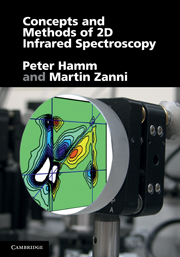Book contents
- Frontmatter
- Contents
- 1 Introduction
- 2 Designing multiple pulse experiments
- 3 Mukamelian or perturbative expansion of the density matrix
- 4 Basics of 2D IR spectroscopy
- 5 Polarization control
- 6 Molecular couplings
- 7 2D IR lineshapes
- 8 Dynamic cross-peaks
- 9 Experimental designs, data collection and processing
- 10 Simple simulation strategies
- 11 Pulse sequence design: Some examples
- Appendix A Fourier transformation
- Appendix B The ladder operator formalism
- Appendix C Units and physical constants
- Appendix D Legendre polynomials and spherical harmonics
- Appendix E Recommended reading
- References
- Index
7 - 2D IR lineshapes
Published online by Cambridge University Press: 05 August 2012
- Frontmatter
- Contents
- 1 Introduction
- 2 Designing multiple pulse experiments
- 3 Mukamelian or perturbative expansion of the density matrix
- 4 Basics of 2D IR spectroscopy
- 5 Polarization control
- 6 Molecular couplings
- 7 2D IR lineshapes
- 8 Dynamic cross-peaks
- 9 Experimental designs, data collection and processing
- 10 Simple simulation strategies
- 11 Pulse sequence design: Some examples
- Appendix A Fourier transformation
- Appendix B The ladder operator formalism
- Appendix C Units and physical constants
- Appendix D Legendre polynomials and spherical harmonics
- Appendix E Recommended reading
- References
- Index
Summary
So far, we have implicitly assumed that the transition frequency ω01 of a vibrational mode is infinitesimally sharply defined and does not vary as a function of time. In an actual sample, this will not be the case because the solvent molecules will push and pull at the molecule, thereby deforming the molecular potential energy surface of the vibrational transition under study and hence modulating its transition frequency ω01 (Fig. 7.1). The time dependence of the transition frequency leads to pure and inhomogeneous dephasing. So far, we have considered pure dephasing by just including a phenomenological T2 damping term whenever the system is in a coherent state. In what follows, we will develop a microscopic theory that explains dephasing and relates it to the microscopic motion of the solvation shell or the molecule itself. Measuring dephasing processes turns out to be a powerful tool to study the dynamics of molecular systems in the solution phase.
Microscopic theory of dephasing
The theory we outline was originally formulated by Kubo to describe the dephasing of NMR transitions [116], but has also proved adequate for describing dephasing of vibrational transitions. Kubo's stochastic theory of lineshapes leads to a microscopic theory of dephasing. It treats the vibrational transitions quantum mechanically, and the solvent classically (it is therefore sometimes called a semiclassical theory of dephasing).
- Type
- Chapter
- Information
- Concepts and Methods of 2D Infrared Spectroscopy , pp. 145 - 165Publisher: Cambridge University PressPrint publication year: 2011
- 1
- Cited by

